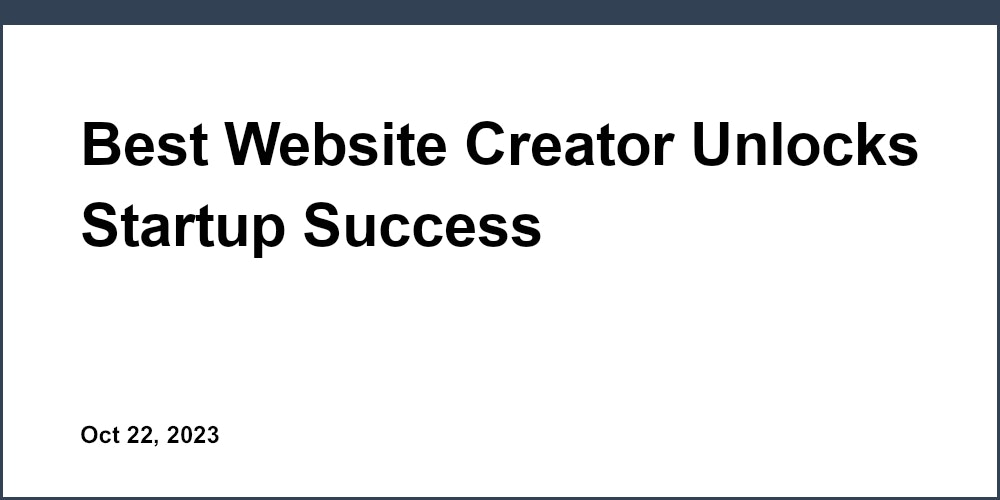Introduction to Designing Your Own Website
Welcome to this guide on designing your own website without needing to code! The goal here is to provide tips and recommendations to empower anyone to create a custom website through intuitive drag and drop editors that require zero coding knowledge.
The key benefits of DIY website builders include flexibility, ease of use, and significant cost savings compared to hiring web developers. With DIY options, you can design a website tailored to your specific needs and preferences without any technical skills.
This guide is intended especially for non-technical founders of startups and small businesses, solopreneurs, bloggers, online store owners, and anyone else looking for a simple yet effective way to build their own website. The great news is that no prior coding experience is required to design an eye-catching, functional site through DIY platforms.
We'll be covering the top website creation platforms that allow you to design various types of websites - from personal blogs and portfolios to ecommerce stores and membership sites. Let's get started!
Choosing the Right DIY Website Builder
Selecting the ideal DIY website builder for your needs depends on several key factors:
Drag and Drop Editors
Opting for a platform with an intuitive drag and drop editor is critical to designing your website purely visually without coding. These WYSIWYG builders allow you to easily drag, drop, and rearrange design elements to create a custom layout. You can seamlessly resize, style, and customize different components to achieve your desired design, no HTML or CSS skills needed!
Leading DIY website builders like Wix, Squarespace, Webflow, Unicorn Platform, and more provide a robust drag and drop experience to empower anyone to bring their website vision to life.
Design Templates
The starting point for many DIY website projects involves choosing and modifying professional templates tailored to different industries and niches. Most builders provide a wide selection of beautifully designed templates spanning various categories - from minimalist blogs to sleek portfolios to fully-featured online stores.
For example, Webflow offers gorgeous minimalist portfolio templates optimized for creatives to showcase their work online.
Leveraging templates can save enormous amounts of time compared to coding a website design from absolute scratch. You can quickly customize the structure, content, images, colors, and more to create a unique site aligned with your brand and audience.
Ease of Use
A DIY website builder aimed at non-coders should provide an exceptionally intuitive editing interface along with detailed tutorials, guides, and reliable customer support. Streamlined setup of domains, hosting, and security features ensures you can focus on designing vs tackling technical complexities.
For instance, Wix is highly renowned for its extensive library of tutorials and guides to empower beginners with no web design experience to get started.
Targeting simplicity and ease of use empowers beginners to craft a custom website aligned with their vision without spending months learning to code. Leading DIY platforms are crafted to make professional web design accessible to all.
Affordable Pricing
Cost is often a major factor for solopreneurs, startups, and small business owners evaluating web design options. Many DIY website builders offer free basic plans to allow creating simple sites at no cost. Paid upgrades are reasonably priced as well, starting at around $5-20 per month.
For example, Wix's basic plan starts at $4/month while Squarespace's basic plan is $12/month.
This represents significant savings compared to hiring web developers and designers, especially for bootstrapped startups and individuals aiming to establish an online presence on a budget. DIY website builders make professional design affordable.
Specialized Features
Certain DIY website builders cater to specific verticals by offering industry-optimized templates and features. For instance, Unicorn Platform provides components tailored to startups such as founder bios, email capture forms, and more.
Similarly, ecommerce-focused options like Shopify offer built-in store management tools while portfolio builders like Carbonmade provide gallery templates. Review your specific goals and target audience to determine if a specialized platform suits your needs.
Comparing Leading DIY Website Builder Options
Now that we've covered the key selection criteria, let's compare some of the top do-it-yourself website builder platforms specifically designed for non-coders:
-
Wix - Extremely robust drag and drop editor with 500+ templates. Ideal for blogs, stores, portfolios, and more. Free plan available.
-
Squarespace - Gorgeous minimalist templates. Includes ecommerce features. Free trial available.
-
Webflow - Advanced customization and animation options. Some coding knowledge recommended.
-
Unicorn Platform - Startup-focused templates and components. Drag and drop blog integration.
-
Weebly - Easy-to-use editor and publishing. Ideal for simpler sites like blogs.
-
WordPress - Open source CMS popular for blogs. Requires self-hosting and setup.
-
Shopify - Robust ecommerce features and templates for online stores.
-
Carrd - Simple one-page sites and landing pages. Basic free plan available.
-
Gator - Hosted platform great for small business websites.
-
Zoho Sites - Builds basic websites with Zoho integration.
The optimal choice depends on your specific goals, technical comfort level, and budget. However, all these DIY website builders allow you to design your own custom website without needing to code.
Many empower solopreneurs, small business owners, startups like Unicorn Platform, and individuals to craft stylish sites aligned with their brand and audience in an accessible, affordable manner. With pre-designed templates and drag and drop editors, you can easily create a unique, quality website showcasing your ideas online.
Key Steps for Designing Your Website
Now let's walk through the core stages involved in designing your own website using a DIY builder platform:
Choose a Template
First, browse the template library and select an appropriate starting point that matches your industry, brand style, and content focus. For instance, ecommerce sites may benefit from a template showcasing products beautifully.
Consider modifying the structural layout and pre-designed page elements if needed so the template aligns with your vision. The goal is to establish an effective foundation that you can then customize further.
Add Your Content
Next, populate the template pages with your own brand messaging, product/service descriptions, images, videos, and other content. Ensure the content is high-quality, engaging, and relevant to your target audience.
For example, an online store should prominently display product photos, pricing, descriptions, and other details website visitors would want to know. Maintain consistency across your content and align with your brand voice and style.
Customize the Design
This stage involves styling and tailoring the template to match your preferences using the drag and drop editor. Change fonts, colors, backgrounds and layouts until you have a design that perfectly encapsulates your brand.
Add new sections or pages such as a contact form, gallery, or blog section as needed. Experiment freely and undo any changes easily since DIY builders make revisions a breeze.
Review and Test Site
Before officially launching your DIY designed website, thoroughly test and review all pages to identify any errors or optimization opportunities. Verify forms submit properly, links work, images load fast, and the site looks great on mobile.
Ideally, ask trusted colleagues or friends to evaluate your site and provide honest feedback from an external perspective. Their input can reveal helpful improvements.
Launch Your Website
Once testing is complete, officially publish your website with a single click since the DIY builder guides you through the technical details like domain setup, security, speed optimization, and search engine submission.
Promote the launch on social media, add Google Analytics to monitor performance, provide special offers or discounts to incentivize visitors, and start driving traffic to your stylish new website!
Optimizing Your DIY Website Design
Here are some tips for continuously improving and refining your DIY designed website both immediately after launch and further down the road:
Design for Your Audience
Research your target demographics and buyer personas thoroughly. Monitor analytics to identify visitor behavior. Then tailor site content, messaging, offers, and design to better resonate with your audience.
For example, prominently featuring customer testimonials and success stories can help build trust and credibility with potential buyers. DIY design allows incorporating feedback and insights to boost engagement.
Focus on Conversions
Beyond traffic metrics, closely track key conversion goals such as email newsletter signups, product purchases, content downloads, or other actions representing a successful visit.
Optimize page layouts, calls-to-action, and content to remove friction and guide visitors to convert. For instance, DIY website builders allow adding bold call-to-action buttons without coding to capture visitor attention.
A/B test variations to determine what resonates best with your audience.
Monitor Performance
Use analytics tools like Google Analytics to monitor traffic sources, visitor engagement, conversions, top-performing pages, referral sites, and other KPIs for free. Identify both high and low-performing areas to inform optimization opportunities.
For instance, a consistently high bounce rate may indicate a confusing homepage design that should be refined. Continuously optimize to boost metrics like pages per session, average session duration, and conversion rate.
Refresh Content
Update website content regularly by publishing new blog posts and articles, case studies, customer testimonials, product updates, and other dynamic information weekly or monthly.
This keeps the site feeling fresh and gives returning visitors new reasons to come back. The easy editing of DIY website builders facilitates regularly adding new, relevant content.
Refine Visual Branding
Evolve the visual branding over time while retaining a consistent core identity across the site. Test introducing new color schemes, page layouts, typefaces, graphics, and styles to keep the design current.
DIY builders make it simple to quickly swap out design elements site-wide. Leverage templates and pre-designed assets during redesigns to simplify the process.
Conclusion and Key Takeaways
To summarize, DIY website builders empower anyone to design their own website without coding through intuitive drag and drop editors and professionally designed templates.
Some key tips include selecting a platform aligned with your specific goals, optimizing pages for conversions and audience engagement, monitoring analytics closely, updating content regularly, and refining the visual design over time.
Services like Unicorn Platform cater specifically to startups and small businesses by offering founder bios, mailing list integrations, and other startup-focused components.
The DIY website creation process is extremely accessible today thanks to powerful platforms that minimize technical barriers. Anyone can now design a custom, mobile-friendly website that effectively communicates their brand, products, services, and story online.
Looking to design your own website? Check out Unicorn Platform's intuitive drag and drop editor and startup-tailored features.



